
Chapter 1
What Is Wireless Radiation?
Wireless devices emit radiofrequency radiation (RFR), sometimes known as wireless radiation, which is the term used in this book.
This radiation is also sometimes called high-frequency radiation, to differentiate it from the lower frequencies emitted by electrical equipment such as power lines.
Wireless devices work by sending and receiving information that is superimposed onto a radiofrequency signal. You could imagine that the wireless radiation is a train travelling from point A to point B. The information (voice, text, or image) is like the passengers it carries. If you block the journey of the train, there is no transfer of passengers. In the same way, if you block the radiation, there is no transfer of data. In other words, wireless networks rely on radiofrequency radiation to carry information.
Wireless networks are constantly transferring information from one wireless point to another, for example:
- from a mobile phone (cell phone) to a base station (cell tower)
- from a cordless handset to its base
- from a laptop to a modem
- from a tablet to a router.
One of the features of wireless radiation is its frequency, which is measured in units called hertz, usually in the range of megahertz (MHz) or gigahertz (GHz). Different technologies operate at different frequencies. Mobile phones generally operate at frequencies from 700 MHz to 2,600 MHz (2.6 GHz). Microwave ovens operate at 2.45 GHz — the same frequency used for wi-fi.
The power of the radiation from a wireless device will depend on the area that the technology is designed to cover. A mobile phone might operate at low power if connecting to a mobile-phone base station nearby, but at much higher power if it were in a low-signal area like a lift or a rural area a long way from a base station.
How much exposure you receive from a wireless device will depend on two things — the power of its signal and the distance between you. The highest exposure occurs close to a wireless device, such as when your mobile phone is directly against your head or your body, or when you’re standing close to a router or cordless phone. However, keep in mind that wireless radiation is nevertheless designed to transmit over distances — up to many kilometres in the case of some mobile-phone base stations.
Over the years, advertisers have coined a range of terms as alternatives to the word ‘radiation’, which has negative connotations. Conversely, they’ve invented negative terms to apply to radiation-free zones. Here are some of those terms and what they really mean:
- ‘energy’ — radiofrequency radiation
- ‘signal’ — radiofrequency radiation
- ‘reception’ — radiofrequency radiation
- ‘wireless’ — radiofrequency radiation
- ‘wi-fi’ — radiofrequency radiation
- ‘Bluetooth’ — radiofrequency radiation
- ‘smart’ meter/TV/appliance — one that emits radiofrequency radiation
- ‘coverage’ — an area covered in radiofrequency radiation
- ‘connect’ — send a signal of radiofrequency radiation to and from
- ‘black spot’ — a radiation-free zone
Would you be as pleased to take advantage of this offer if the sign said ‘Free radiation’?
